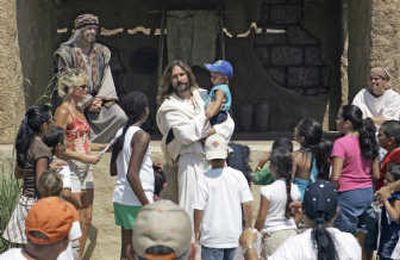TBN boosts attraction

ORLANDO, Fla. – Jesus Christ is crucified and resurrected here six days a week.
Snarling Roman soldiers whip and drag him, and somber audience members watch. Some quietly weep.
It is the grand finale at the Holy Land Experience – not the attraction most tourists envision as part of an Orlando vacation.
Just miles from Walt Disney World, Universal Orlando and SeaWorld in this city’s overstimulated tourist corridor, Holy Land has in its six years of operation aimed to re-create Jerusalem of Biblical times.
It is often referred to as a “Christian theme park,” but it offers lectures, not rides. Its officers prefer to call it a “living biblical museum.”
Whatever you call it, until last month, the nonprofit operation was troubled. Management changed hands, its founder left and attendance was flat.
But suddenly, a savior appeared.
Trinity Broadcasting Network, a California-based Christian empire with 12,500 worldwide TV and cable affiliates, has taken over Holy Land and its estimated $8 million mortgage.
Both are nonprofit organizations, so Trinity describes the deal as a “marriage” rather than a purchase, saying little money changed hands.
Already, ticket sales are up 25 percent, thanks to mentions on TBN broadcasts. An expansion is planned that will include new shows and a new Trinity television studio.
“We believe that the way this came together, it was designed by God for us to continue the way we need to,” park president Tom Powell says.
“I don’t think the end result is because of anything any person did. I think it’s the end result of what everyone here was asking for.”
Holy Land previously had almost no advertising budget, relying on word-of-mouth testimonials and tourists who happened to drive by.
Admission prices have risen from less than $20 originally to $35 to $40 today. But ticket sales don’t cover costs, so the park relies heavily on donations from benefactors, foundations and visitors slipping money into boxes scattered around the park.
The park has a “scriptorium,” an opulent-looking building with an enormous collection of rare Bibles and artifacts. Powell says it is the largest of its kind outside the Vatican.
Other stops include a scale model of Jerusalem, an exhibit on the Dead Sea Scrolls and a model of the garden tomb where Christ was supposedly buried.
Vendors and actors wear head coverings and billowing cotton rags, and gift shops sell Bibles and other Christian items. Among them are a genealogical map linking Adam to Jesus, along with handbags, necklaces and T-shirts.
Also for sale are yarmulkes and menorahs – a nod to Holy Land’s founder.
The attraction opened in 2001, the vision of a New Jersey preacher who came South to expand his reach.
It was controversial because the Rev. Marvin Rosenthal is a Baptist who was born Jewish and now considers himself a “Hebrew Christian” or “Messianic Jew.” That means he believes Jesus is the Messiah, contrary to traditional Jewish beliefs.
Some local Jews were upset he was creating an attraction, and their conflict made international news when the park started.
Rosenthal left Holy Land two years ago, saying it was simply time to move on. He now runs a Clermont, Fla.-based ministry called Zion’s Hope and has no contact with the park.
Trinity didn’t intend to get into the biblical attraction business but was looking for an Orlando location for a new TV production studio, chief of staff Paul Crouch Jr. says.
Now the organization will build it at Holy Land and could make TV and movie filming a part of the guest experience.
“It’ll be a faith-based version of Universal Studios,” Crouch says. “We can shoot movies there. We can do concerts. We can do TV shows.”
Holy Land’s offerings, many of them outdoor shows, change regularly. Recent performances ranged from “The Ministry of Jesus,” a 15-minute act where Christ heals a blind man and inspires a tax collector, to a 30-minute Southern gospel concert and a re-enactment of the Resurrection.
Audience members are encouraged to participate. Jesus walks among them with a wireless microphone, calling children and picking some up.
Park President Powell says not all visitors are Christian, and some have never even been to church before. Fourteen Hindu monks passed through the other day, he says.
Trinity’s Crouch says he thinks of Holy Land as a ministry, not a theme park.
“When I went there for the first time about six or seven months ago, I didn’t go there to be entertained, and I didn’t see a theme park taking place,” he says.
“I saw people praying for each other. I saw Bible studies going on. I saw teaching going on.
“At the end of the day, I felt like I had gone to church, not just gone to Disneyland.”